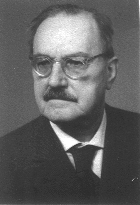


The Diatom Collection of Franz Josef Weinzierl
Franz Josef Weinzierl
 Franz Josef Weinzierl was born on February 21st, 1888 and lived in Landshut,
the capital of Lower Bavaria (Southern Germany), until his death in 1969.
Stimulated by the work of Anton Mayer, a famous diatomologist in Regensburg,
Weinzierl began to build up a collection of diatoms from the local
flora in 1919. In the following years Weinzierl and Mayer enjoyed a long and productive
cooperation. During Mayer's final illness and after his death, Weinzierl
rearranged Mayer's collection in Regensburg, to make it the valuable collection
which is still used today (e.g. for Pinnularia; Krammer 1992).
Franz Josef Weinzierl was born on February 21st, 1888 and lived in Landshut,
the capital of Lower Bavaria (Southern Germany), until his death in 1969.
Stimulated by the work of Anton Mayer, a famous diatomologist in Regensburg,
Weinzierl began to build up a collection of diatoms from the local
flora in 1919. In the following years Weinzierl and Mayer enjoyed a long and productive
cooperation. During Mayer's final illness and after his death, Weinzierl
rearranged Mayer's collection in Regensburg, to make it the valuable collection
which is still used today (e.g. for Pinnularia; Krammer 1992).
After World War II, he was encouraged by Prof. Dr. K. Mägdefrau, professor at
the Ludwig-Maximilians-Universität München, to enlarge his collection. As well
as samples of extant diatoms he also added collections of fossil taxa. He
studied and made slides from selected material of several important exsiccate
sets (e.g. Kützing, F.T, Algarum aquae dulcis germanicarum, Rabenhorst, G. L.,
Die Algen Sachsens and Rabenhorst, G. L., Die Algen Europa's, Fortsetzung der
Algen Sachsens, resp. Mittel-Europa's). In the course of his extensive work he
developed a new medium for making permanent slides of diatoms which he published
(Weinzierl 1949 a, b; 1956).
Weinzierl maintained a lively correspondence with other diatomologists, such
as A. Cleve-Euler, F. Hustedt, G. Krasske, F. Meister, C. Reimer, H. Schimanski,
received material from some of them and expanded his collection continuously.
Hustedt's description of Cyclotella tenuistriata Hustedt [today
Cyclotella glabriuscula (Grunow) Håkansson]
was partly based on material from Bavaria (river Isar) collected and provided by Weinzierl (Hustedt 1952).
Between the years 1919 and 1967, Weinzierl established the largest Bavarian
collection of diatoms. Detailed and comprehensive records, photographs and a library as
well as the extensive correspondence with other diatomologists are valuable
assets of this significant collection. He donated his diatom collection to the
Botanische Staatssammlung München, which it received after his death on March
29th, 1969.
References:
- Hustedt, F. 1952: Neue und wenig bekannte Diatomeen. IV. – Bot. Not.105(4): 366–410.
- Krammer, K. 1992: Die Gattung Pinnularia in Bayern. – Hoppea 52: 5–291.
- Weinzierl, F. J. 1949a: Einige neue Verfahren bei der Diatomeenpräparation. – Mikrokosmos 38(10): 234–237.
- Weinzierl, F. J. 1949b: Einige neue Verfahren bei der Diatomeenpräparation. (Schluß). – Mikrokosmos 38(11): 254–256.
- Weinzierl, F. J. 1956: Das Diatomeeneinschlußmittel nach Weinzierl. – Mikrokosmos 45(4): 94–96.
© SNSB – Botanische Staatssammlung München and Bayerisches Landesamt für Wasserwirtschaft 2001–2025. All rights reserved.
 Franz Josef Weinzierl was born on February 21st, 1888 and lived in Landshut,
the capital of Lower Bavaria (Southern Germany), until his death in 1969.
Stimulated by the work of Anton Mayer, a famous diatomologist in Regensburg,
Weinzierl began to build up a collection of diatoms from the local
flora in 1919. In the following years Weinzierl and Mayer enjoyed a long and productive
cooperation. During Mayer's final illness and after his death, Weinzierl
rearranged Mayer's collection in Regensburg, to make it the valuable collection
which is still used today (e.g. for Pinnularia; Krammer 1992).
Franz Josef Weinzierl was born on February 21st, 1888 and lived in Landshut,
the capital of Lower Bavaria (Southern Germany), until his death in 1969.
Stimulated by the work of Anton Mayer, a famous diatomologist in Regensburg,
Weinzierl began to build up a collection of diatoms from the local
flora in 1919. In the following years Weinzierl and Mayer enjoyed a long and productive
cooperation. During Mayer's final illness and after his death, Weinzierl
rearranged Mayer's collection in Regensburg, to make it the valuable collection
which is still used today (e.g. for Pinnularia; Krammer 1992).

